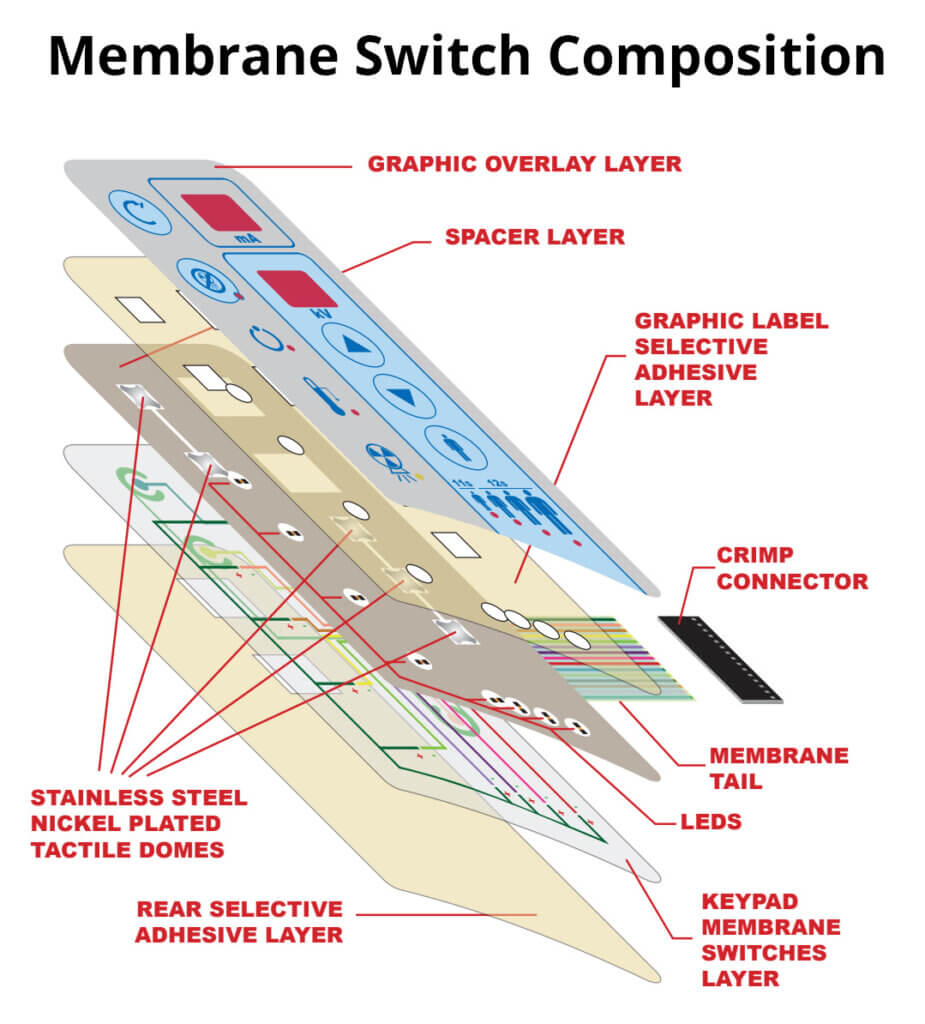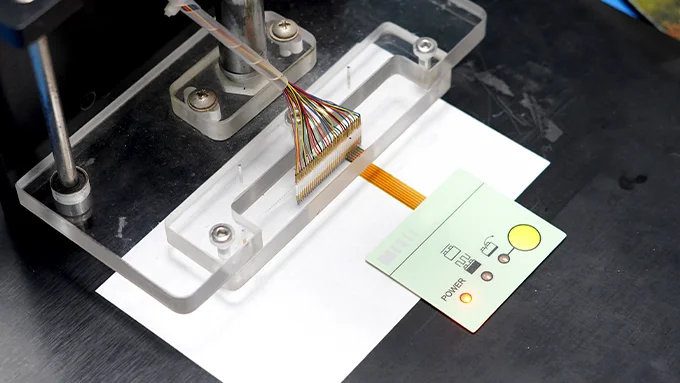Top benefits to use membrane switch in modern devices
The Production Process Behind Membrane Layer Change: What You Need to Know
The production process behind membrane layer switches combines cautious design, product selection, and top quality control. It begins with comprehending the intricacies of membrane button design and proceeds through numerous phases, including product options and printing strategies. Each phase plays a vital duty in guaranteeing capability and sturdiness. The intricacies of layer construction and the strenuous testing standards might expose insights that are not promptly obvious. What exists past these fundamental aspects?
Comprehending Membrane Layer Switch Style
Membrane layer buttons may show up easy at very first glimpse, their layout involves intricate factors to consider that guarantee capability and resilience. The layout process starts with a complete understanding of individual requirements, consisting of the interface's desired application and environmental factors. Functional designs is a crucial element, as the layout has to assist in simplicity of usage while ensuring that tactile comments fulfills individual expectations.Moreover, the layering of elements, such as visuals overlays, adhesive layers, and conductive traces, have to be precisely crafted. membrane switch. This layered setup not just influences the button's responsiveness however likewise impacts its long life. Interest is offered to the sealing strategies utilized to safeguard versus wetness and dust, which might jeopardize efficiency. In addition, layout considerations encompass appearances, where color pattern and aesthetic clearness improve individual experience. Ultimately, the design of membrane layer switches balances capability, individual experience, and durability, guaranteeing that they satisfy the demands of various applications effectively
Products Made Use Of in Membrane Layer Switch Over Manufacturing
When picking materials for membrane button manufacturing, it is vital to contemplate both performance and resilience. The primary products consist of polyester and polycarbonate movies, which offer versatility and stamina. These movies are typically coated with glue to ensure proper bonding to substrates. Conductive inks, commonly composed of silver or carbon, are important for producing electric connections within the button, allowing for reliable operation.Additionally, a safety layer, such as a hard layer, is regularly put on enhance scratch resistance and long life. The option of backing product, such as acrylic or foam, can significantly impact the switch's tactile feeling and total user experience. Furthermore, various environmental factors, consisting of temperature and moisture, should lead material choice to guarantee peak efficiency in particular applications. Ultimately, the right combination of materials adds to the membrane button's capability and life expectancy, making informed choices necessary for manufacturers.
The Printing Refine: Creating Graphics and Text
The printing procedure in membrane layer button manufacturing plays a substantial function in generating top quality graphics and text. Various visuals design strategies are utilized to assure visual charm and capability, while careful ink option techniques are crucial for sturdiness and efficiency. Comprehending these elements is essential for achieving best cause membrane switch design.
Graphic Design Techniques
Graphic style strategies play a crucial role in the printing procedure of membrane switches, as they specify how graphics and message will eventually appear on the end product. Effective graphic design includes the strategic use formats, shades, and fonts to enhance readability and visual appeal. Designers commonly make use of vector graphics for scalability, making certain that photos remain sharp at numerous dimensions. Additionally, attention to comparison and positioning is essential, as it influences customer communication and visual high quality. The incorporation of branding aspects, such as logos, need to be managed with treatment to keep brand integrity. In general, thoughtful visuals design strategies contribute considerably to the capability and beauty of membrane buttons, influencing individual experience and product efficiency.
Ink Option Techniques
Choosing the suitable ink is important for achieving the wanted visual top quality and durability in membrane button production. Different ink types are made use of, including solvent-based, water-based, and UV-curable inks. Each type offers distinctive features, such as adaptability, bond, and resistance to ecological variables. Solvent-based inks are typically favored for their toughness and dynamic shades, while water-based inks are much more ecologically friendly however might have restrictions in adhesion. UV-curable inks supply fast healing and robust performance. Furthermore, color matching strategies ensure that the picked inks straighten with layout requirements. Eventually, the choice of ink should think about variables such as application approach, substrate compatibility, and end-use requirements to achieve remarkable lead to membrane layer switch graphics and text.
Layer Building and Assembly

Material Option Process
A careful choice of materials is important in the manufacturing process of membrane buttons, as it straight affects performance and sturdiness. The primary products made use of consist of polyester, polycarbonate, and numerous conductive inks. Polyester is often favored for its outstanding resistance to chemicals and abrasion, making it appropriate for extreme atmospheres. Polycarbonate, on the other hand, supplies exceptional quality and impact resistance, which is helpful for applications calling for visibility and robustness. Conductive inks, usually made up of silver or carbon, are crucial for creating reliable electric paths. Additionally, the selection of sticky products impacts the total honesty of the button - membrane switch. Assessing factors such as ecological exposure, responsive responses, and aesthetic requirements guides suppliers in selecting the most effective products for their details applications
Layer Adhesion Techniques
Sticking layers in membrane switch building is an essential process that ensures performance and durability. Various attachment methods are employed to secure suitable bonding between layers, which usually consist of making use of adhesives, heat, and pressure. Pressure-sensitive adhesives (PSAs) are typically utilized for their ease of application and instant bonding abilities. Additionally, thermal bonding strategies can be applied, where warmth is used to activate glue properties, safeguarding a strong bond. The selection of this adhesion technique largely depends upon the products involved and the particular application requirements of the membrane switch. Correct placement and consistent application of adhesives are crucial to avoid flaws, safeguarding the switch operates efficiently throughout its intended life-span.
Quality Control Actions
Guaranteeing high quality control throughout the layer construction and assembly of membrane layer switches is necessary for preserving efficiency and reliability. This procedure usually involves several important procedures, consisting of detailed evaluations at each phase of production. Manufacturers use advanced testing approaches, such as peel tests and attachment analyses, to confirm the integrity of layer bonds. Additionally, visual assessments are carried out to recognize any type of problems in printing or product inconsistencies. Ecological conditions, such as temperature level and moisture, are thoroughly kept an eye on to guarantee suitable curing and bond. Regular calibration of devices assists keep specific production standards. By carrying out these quality assurance steps, suppliers can substantially decrease the danger of item failing, guaranteeing that the final membrane changes meet the needed requirements and client expectations.
Testing and Top Quality Control Actions

Technologies in Membrane Layer Switch Technology
As improvements in modern technology continue to progress, membrane switches are gaining from cutting-edge developments that boost their performance and user experience. One remarkable development is the integration of capacitive touch technology, which enables for more receptive and intuitive user interfaces. This change not only enhances appearances but additionally reduces mechanical damage, prolonging the life expectancy of the switches.Additionally, improvements in visuals overlay materials have actually brought about boosted durability and resistance to environmental elements such as wetness and UV light. These products now supply boosted clarity and illumination, additional raising the aesthetic appeal.Furthermore, the incorporation of wise technology is transforming membrane switches right into interactive control panels, allowing connection with IoT tools. This connection fosters a seamless individual experience, paving the way for applications in different industries, from medical care to customer electronics. Jointly, these developments placement membrane layer switches as crucial components in modern-day device layout.
Regularly Asked Inquiries
How Lengthy Does the Membrane Change Manufacturing Process Take?
The period of the membrane layer button production procedure can vary significantly. Variables such as intricacy, materials used, and manufacturing quantity impact timelines, with typical manufacturing varying from a few days to numerous weeks for conclusion.
What Are the Usual Applications for Membrane Layer Buttons?
Membrane layer buttons are typically made use of in different markets, consisting of vehicle controls, family devices, medical devices, and consumer electronic devices (membrane switch). Their adaptability and resilience make them ideal for applications requiring user-friendly review interfaces and trustworthy efficiency in diverse atmospheres
Can Membrane Switches Be Personalized for Certain Demands?

What Is the Lifespan of a Common Membrane Switch?
The life expectancy of a common membrane button differs, yet generally, it varies from 1 to 5 million cycles. Factors such as use, environment, and worldly top quality considerably affect resilience and overall efficiency with time.

Are Membrane Layer Switches Ecologically Pleasant?
The ecological friendliness of membrane switches varies. Some materials used may not be recyclable, while others can be environmentally friendly. The overall effect depends upon manufacturing materials and methods, demanding careful consideration throughout option and disposal. The production process behind membrane changes combines mindful design, material choice, and top quality control. It begins with comprehending the intricacies of membrane button design and advances with various phases, consisting of product choices and printing strategies. When choosing products for membrane layer button manufacturing, it is vital to ponder both efficiency and durability. A careful selection of materials is vital in the production process of membrane switches, special info as it directly affects capability and toughness. The option of attachment method mostly depends on the products entailed and the details application requirements of the membrane layer button.